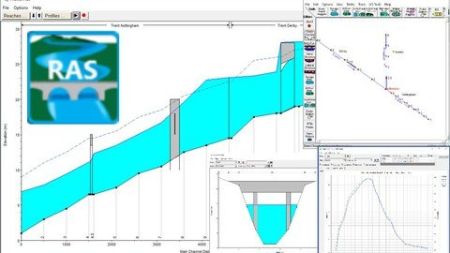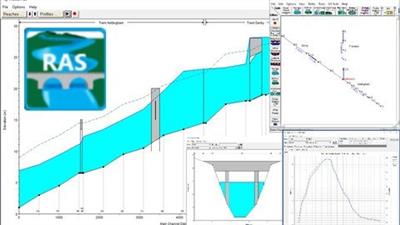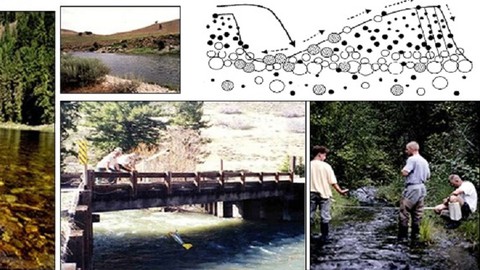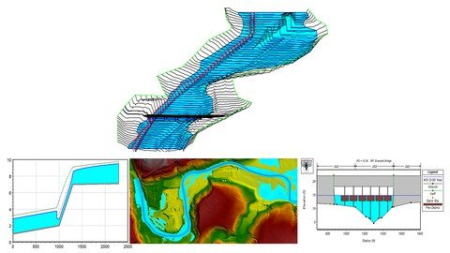
A Practical Introduction To 2D River Modelling In Hec-Ras
Posted on 16 Oct 05:19 | by LeeAndro | 24 views
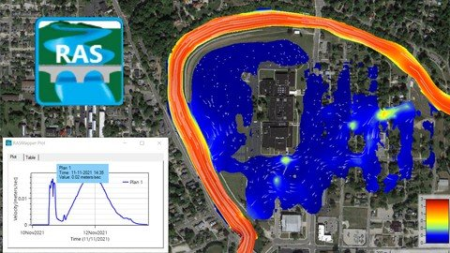
Last updated 3/2022MP4 | Video: h264, 1280x720 | Audio: AAC, 44.1 KHzLanguage: English | Size: 5.29 GB | Duration: 8h 11m
A step-by-step guide to building, running and interpreting 2D models using RAS Mapper in HEC-RAS
What you'll learn
Learn to work with RAS Mapper within the HEC-RAS software environment to create terrain layers for 1 and 2D river modelling.
Learn how to import 1D cross-section data and use it to create a more accurate channel. network.
Learn how to create Landcover Layers and apply Manning's n values.
Learn how to create a 2D mesh, set cell parameters and add Refinement Regions and Breaklines.
Learn how to build Lateral Structures in order to connect 1D to 2D elements.
Learn how to adjust a 2D area to create an optimal river channel mesh.
Learn how to enter unsteady flow Boundary Condition data and Initial Conditions.
Learn how to set up an Unsteady Run and about Computation Options and Tolerances.
Learn how to pick an appropriate -step using the Courant Number.
Learn how to view 1D and 2D results and understand what the outputs mean.
Requirements
A basic understanding of the concepts involved in river hydraulic modelling would be beneficial but the course learning goals can be achieved without the need for any prior experience of using HEC-RAS.
Description
In this course you will learn, through 54 short video tutorials, how to construct a combined 1D-2D and a 2D-only river model in the HEC-RAS hydraulic modelling software package. This course, builds on my Udemy 1D HEC-RAS modelling course but is stand-alone and you do not need to take that course in order to follow and complete this one although it would be useful to have a basic understanding of general hydraulic modelling concepts.All the data necessary to follow and build your models is supplied with this Udemy course and the HEC-RAS software itself is free to from the web.Much of the tutorial and model build will focus on the use of the RAS Mapper module within the HEC-RAS software environment. You will learn how to import terrain model data, modify it using surface interpolation techniques and how to create landuse data layers to generate roughness data. You will then go on to learn about 2D geometry creation, how to set cell size and how to adjust cell spacing and alignment to best represent the underlying terrain and likely flow patterns and, in your first model, you will then go on to create a lateral structure to connect 1D to 2D areas. In the second model that you build you will also learn how to represent a main river-channel within a 2D model surface. You will then learn how to enter boundary condition flow data and how to run model scenarios. Several of the tutorials are then focused on discussing both 1D and 2D computation options and tolerances and also how to set the computation interval based upon the Courant Number. You will learn about these various aspects of modelling by making adjustments to your model and then viewing the impact had on the computed results output. Finally, you will learn how to view and manipulate both 1D results in the main HEC-RAS software environment and 2D outputs in RAS mapper along with tips on how to best interrogate and display the output data.This course will enable you to advance your hydraulic modelling skills from 1D-only simulations to 2D modelling within a geo-referenced terrain environment and as such it will stand you in good stead whether you study river channel processes in academia or work in the river eeering industry.
Overview
Section 1: Introduction
Lecture 1 Introduction
Lecture 2 Course Material
Lecture 3 HEC-RAS Installation
Lecture 4 Creating a New Project
Section 2: Creating a Terrain Model and Manning's n Layers
Lecture 5 Uploading a Projection File
Lecture 6 Uploading a Terrain Model
Lecture 7 Importing Geometry Data
Lecture 8 Creating Bank Lines
Lecture 9 Creating a New Terrain Layer
Lecture 10 Adding Map Data
Lecture 11 Creating a Manning's n Layer
Lecture 12 Manning's n Values and Classification Polygons
Lecture 13 Creating a User Defined Manning's Layer
Section 3: Building a 2D Geometry Layer
Lecture 14 2D Peter Creation
Lecture 15 Geometry Editing Tools
Lecture 16 2D Area Mesh Updates and Hydraulic Properties
Lecture 17 Breaklines
Lecture 18 Refinement Regions
Lecture 19 Manning's n Calibration Regions
Lecture 20 Managing Associations
Lecture 21 Cell Generation and Hydraulic Properties Tables
Section 4: Building a Lateral Structure
Lecture 22 Lateral Structure 1
Lecture 23 Lateral Structure 2
Lecture 24 Lateral Structure 1 Data
Lecture 25 Lateral Structure 2 Data
Section 5: Usteady Flow Data, Computation Setup and Calculation Options
Lecture 26 Unsteady Flow Data Entry
Lecture 27 Unsteady Flow Computation Setup
Lecture 28 Calculation Options 1
Lecture 29 Calculation Options 2
Lecture 30 Calculation Options 3
Lecture 31 Perfog an Unsteady Run
Section 6: Model Results
Lecture 32 1D Results Part 1
Lecture 33 1D Results Part 2
Lecture 34 2D Results Part 1
Lecture 35 2D Results Part 2
Lecture 36 2D Results Part 3
Section 7: Adjusting Computation Factors and the Courant Number
Lecture 37 Adjusting 1D Computation Factors
Lecture 38 Adjusting 2D Equations
Lecture 39 Adjusting 2D Computation Options
Lecture 40 Selecting an Appropriate Step
Lecture 41 Adaptive Step Selection
Section 8: Creating a 2D-Only Model
Lecture 42 Creating a Copy of Your Model
Lecture 43 Creating a New 2D Flow Area
Lecture 44 Channel Refinement Region
Lecture 45 Refinement Region Cell Sizing
Lecture 46 Channel Centre Breakline
Section 9: Boundary Condition Data, Unsteady Flow Simulation and Results
Lecture 47 Boundary Condition Lines
Lecture 48 Discussion about Boundary and Initial Conditions
Lecture 49 Boundary Condition Data
Lecture 50 Unsteady Flow Simulation and Results
Lecture 51 Unsteady Flow Simulation with Adjusted Roughness
Section 10: The RASter Calculator, Conclusions and 3D Viewing
Lecture 52 The RASter Calculator
Lecture 53 Conclusions: When to Use 1D and 2D Models
Lecture 54 Bonus Lecture - The 3D Viewer
Section 11: UPDATES: Geometry data manipulation
Lecture 55 Entering and processing geo-referenced 1D cross-section data for RAS Mapper
Lecture 56 Extracting 1D cross-section data from a high resolution terrain model
Those interested in advancing their hydraulic modelling skills from 1D to 2D modelling using RAS Mapper within the HEC-RAS software package.
HomePage:
Https://anonymz.com/https://www.udemy.com/course/a-practical-introduction-to-2d-river-modelling-in-hec-ras/DOWNLOAD
1dl.net
https://1dl.net/7xeawwnmsmdr/XWMgcx4b__A_Practica.part1.rar.html
https://1dl.net/4u20evt6y33p/XWMgcx4b__A_Practica.part2.rar.html
https://1dl.net/sn5hrlemfa52/XWMgcx4b__A_Practica.part3.rar.html
https://1dl.net/6bhmkqy2zn9j/XWMgcx4b__A_Practica.part4.rar.html
https://1dl.net/zkurxzngzogf/XWMgcx4b__A_Practica.part5.rar.html
https://1dl.net/6amq2ldadwq6/XWMgcx4b__A_Practica.part6.rar.html
uploadgig.com
https://uploadgig.com/file/download/2eED05090f354505/XWMgcx4b__A_Practica.part1.rar
https://uploadgig.com/file/download/844eB3EA1d22f894/XWMgcx4b__A_Practica.part2.rar
https://uploadgig.com/file/download/d4a22A3233d021DE/XWMgcx4b__A_Practica.part3.rar
https://uploadgig.com/file/download/1da75815d15cE7b3/XWMgcx4b__A_Practica.part4.rar
https://uploadgig.com/file/download/767ef8776fd8aFD3/XWMgcx4b__A_Practica.part5.rar
https://uploadgig.com/file/download/b34e0Bd5528e5920/XWMgcx4b__A_Practica.part6.rar
rapidgator.net
https://rapidgator.net/file/8cbe1060fb5bfd61ea91a72e757905b6/XWMgcx4b__A_Practica.part1.rar.html
https://rapidgator.net/file/7a4488b38ca2521c6aadb1c0f438e762/XWMgcx4b__A_Practica.part2.rar.html
https://rapidgator.net/file/5413f83dc1d63dc08600d6c6f2d55058/XWMgcx4b__A_Practica.part3.rar.html
https://rapidgator.net/file/953cb57eb81e38faf04245ff8dc4fbcf/XWMgcx4b__A_Practica.part4.rar.html
https://rapidgator.net/file/a4332029035a4efe3778218b6742b09c/XWMgcx4b__A_Practica.part5.rar.html
https://rapidgator.net/file/ab405dca94508b400fb564bbefeaaed6/XWMgcx4b__A_Practica.part6.rar.html
Related News
System Comment
Information
 Users of Visitor are not allowed to comment this publication.
Users of Visitor are not allowed to comment this publication.
Facebook Comment
Member Area
Top News
